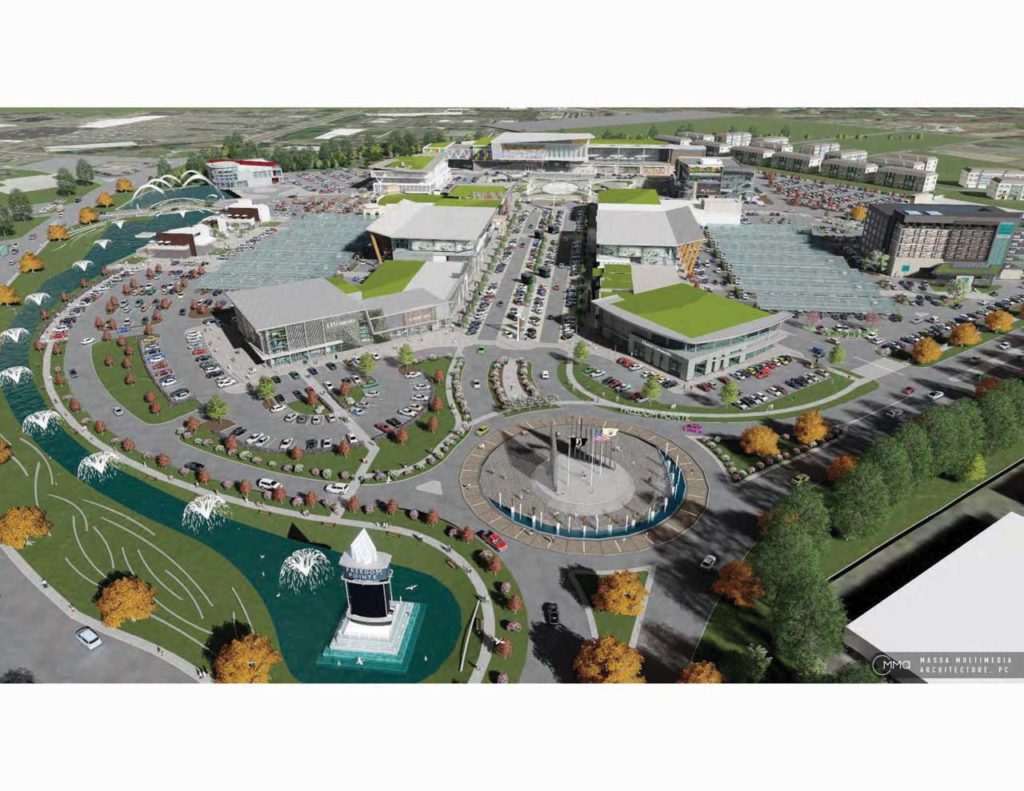A legendary 100-year-old U.S. Army base-turned-ghost-town is reborn as a futuristic Metropolis
by Laura D.C. Kolnoski • photos by robert nuzzie
On the same hallowed ground where night vision goggles were invented and the U.S. military’s World War II homing pigeon program was headquartered, a transformation is underway. Closed by the U.S. Army in 2011, the 1,127-acre Fort Monmouth in Monmouth County is again alive with new projects and tenants.

A 1941 Dance Hall is being converted into a microbrewery/event space. Six bland barracks will be rebuilt into a vibrant arts center. Extensive renovations at the historic officers’ homes fronting the Parade Grounds will create 117 for-sale and rental residences. The once dreary marina, battered by Superstorm Sandy, has undergone a Cinderella-like makeover and is now a picturesque year-‘round waterfront dining destination.
Geographically, the fort spans three towns—Eatontown, Oceanport, and Tinton Falls. A complete city, it is filled with offices, residences, retail, recreation, a post office, fire department, research and development centers, a golf course, and a vast array of support buildings. Slicing up this extra arge pie for sale was no easy feat, either; a public-private agency formulated a plan over several years, carving the property into “parcels.” To execute the transactions, the Fort Monmouth Economic Revitalization Authority (FMERA) took over. Supported by staff and volunteer expert advisors, voting members from state, county, local, and private interests usher each parcel from public offering through closing.

Army bureaucracy meant a slow, tedious process until one long-time player, Monmouth County Freeholder Director Lillian G. Burry, conceived a way to essentially “buy out” from the Army through a mortgage financing plan that benefited from the county’s AAA bond rating. Finalized last November, the agreement provided $35 million to eliminate military oversight, and the loan will be paid through fort land sales within ten years.
“Purchasing the fort was important,” said FMERA Chairman James V. Gorman, the CEO of the American Property Insurance Company, who was appointed by Governor Chris Christie to head FMERA. “Before, we were required to go through six different Army departments and then get approval from the Department of Defense, taking an average of 30 months for construction on a new project to start. Things are now developing dramatically. We are on a strong track with shoulders to the wheel, all pushing in the same direction.”

“It takes a special kind of investor to take on a project at a closed military installation,” said FMERA Executive Director Bruce Steadman, who also oversaw the closure at New York’s Plattsburgh Air Force Base. He said 65 percent of Fort Monmouth properties are “now in play.”
Some 5,000 civilian jobs were lost when the fort closed, and surrounding businesses suffered. FMERA Director of Real Estate Development David Nuse said a goal of 10,000 jobs by 2027 has been set, with 1,200 permanent positions already created.
“Lifestyle, amenities, and employment opportunities will attract young people to live and work here,” he added. “Over $1.5 billion will be invested.” (Developers must follow construction guidelines as well as adhere to job creation quotas or face fines for noncompliance.)

A Storied Past
Established as the Signal Corps training facility in 1917, the base gained permanent status in 1925, specializing thereafter in research, development, and logistics support. In 1928, the first radio-equipped meteorological balloon soared into the atmosphere. In 1938, the first U.S. aircraft detection radar was developed there. The Diana Radar was used to bounce electronic signals off the moon in 1946.
In 1991, Fort Monmouth’s Communications Electronics Command (CECOM) provided support and equipment for soldiers, including radios, jammers, and night vision and intelligence systems during global conflicts. Many former civilian employees still won’t discuss the top-secret projects they worked on there.
The Future Takes Shape Inspired by the past, planners sought high-tech, scientific, and educational occupants. Some have already materialized. CommVault, a software company, built its 275,000-square-foot headquarters on 55 acres. AcuteCare Health Systems now occupies the repurposed, 100,000-square-foot former Patterson Hospital, and an all-girls high school purchased and transformed a former childcare facility into its new campus. AASKI Technology acquired one office building and TetherView, a cloud solution business, purchased another, joining with the co-working organization vi Collaboration Hub.
“We’re seeing a trend of technologists and entrepreneurs rising up in Monmouth County,” vi co-founder Chris Pallé said. “By creating an environment conducive to collaboration, the talent in those groups is multiplied, and the more innovation and ideas we can create. It’s the future of work.”
“We saw the potential Fort Monmouth presents as a hub of economic activity for the region, particularly within the technology industry,” Commvault CEO N. Robert Hammer said. “We are confident the fort will continue to attract other innovative organizations.”

Not all who came to the table found a seat. Some developers were rejected when their plans didn’t pass muster or their bids were too low. When others offered viable “outside the box” proposals, FMERA listened and loosened parameters. Prospective buyers continue taking guided tours of available parcels.
The recent re-opening of the “Avenue of Memories”—a portion of County Route 537—through the fort allows public access for the first time since 9-11. Officials believe viewing the fort’s progress will inspire public confidence and encourage investment.
“We continue to see strong interest from those looking to be part of Fort Monmouth’s next chapter,” said Les Smith of master broker Cushman & Wakefield. “This project has so much potential, bolstered by its prime location near transportation and the Jersey Shore.”
Freeholder Burry also secured parcels for public use, primarily in exchange for in-kind services. The fort’s former Motor Pool is now a county Public Works outpost, and the Parks Department has been welcoming thousands to the fort’s Recreation Center for two years. To perpetuate the military legacy, she is spearheading the creation of a veteran’s housing community and a veterans’ services office, and works on historic preservation matters.
STATUS REPORT
Freedom Pointe (see sidebar) The centerpiece of Fort Monmouth’s redevelopment is this large upscale lifestyle center. With stores, residences, offices, entertainment, open space, and more, it’s planned for 2019 completion.
Fitness Center
Headed by Rumson-Fair Haven High School basketball coaches Chris Champeau and Dave Callahan, FM Partners, LLC is purchasing the fort’s former fitness center on 7.75 acres. It will be upgraded, expanded, and reused as a fitness/wellness center with modern equipment and a pool. “This area needs fields and courts, and the fitness center is a top-of-the-line jewel,” Champeau said. “We also hope to employ veterans. We’re fired up.”
Arts/Cultural Community
Six World War II-era barracks on 4.4 acres will become a cultural hub, courtesy of local businessman, art patron, and philanthropist Kenneth Schwartz. “When the fort closed it was like a cold wind came through,” he said. “Some of the soldiers stationed here were customers at my auto dealerships. I wanted to do this project.” Envisioning studios and galleries for dance, music, and arts augmented by classes, seminars, and related activities, Schwartz quipped, “It will be Woodstock…without the pot.”
Suneagles
Proposals for the landmark 171-acre golf course and its picturesque Gibbs Hall banquet facility were being evaluated at press time. A hotel/conference center and up to 75 residential units were originally planned, but officials are entertaining alternate proposals. The course continues to operate under a management company.
Barker Circle
March 31 is the deadline for bids on seven buildings and a commissary in the 19-acre complex in the fort’s historic district. The parcel includes the post firehouse, Kaplan Hall museum, and the adjacent, 12.6-acre Allison Hall parcel, which can accommodate a boutique hotel and/or alternate complementary uses.
Lodging Area
Proposals are coming next for the 15-acre, eight building waterfront Lodging Area on Parker’s Creek, slated for residential, institutional/civic, and/or office/research.
Oceanport Municipal Complex
To replace structures destroyed by Superstorm Sandy, the borough will buy and renovate a 13-acre site into a new borough hall and municipal complex; funded by FMEA, Monmouth County, and revenue from the sale of the old property. A library, senior/community center, police department, and public works will move in.
Future Develo pments
Coming to market next are the fort’s Bowling Center in Eatontown, slated for re-use, and the McAfee Center Complex in Oceanport, envisioned as a technology, office/research, and development hub.
“Fort Monmouth’s redevelopment is extraordinarily important for New Jersey,” said Timothy Lizura, Chief Operating Officer of the New Jersey Economic Development Authority and a FMERA member. “We envisioned this as a 20-year effort, but are well in advance of that. The FMERA team has done a tremendous job. We are very pleased with the developers and businesses. It will be a sustainable and impressive development.”
Fort Monmouth Economic Revitalization Authority
502 Brewer Avenue, Oceanport / 732.532.9000
fortmonmouthnj.com
A CROWN JEWEL
BEGINS TO SHINE
An audible delighted reaction greeted the unveiling of a large rendering of the coming planned community, Freedom Pointe, described as “a premier, mixed-use lifestyle destination” at a recent media event in Oceanport. One answer to the much-asked question, “What is happening at Fort Monmouth?” was offered resoundingly. One of the highest-profile of the scores of new projects in various stages of development at the former U.S. Army base, the much-anticipated Freedom Pointe has been described as the area’s crown jewel.
To be located directly inside the former fort’s main Johnson Gates off Route 35 in Eatontown, the 89-acre development is designed as a walkable town center, surrounded by a man-made canal graced by “Bellagiostyle” fountains, with 350,000 square feet of retail, and 302 residential units. Designed as a community hub, amenities include an ice skating rink, open lawn area for concerts, shows, and seasonal events, jogging and biking trails, a high-end playground with kiddie spray park, miniature golf, fire pits, and bocce courts, in addition to a planned movie theatre, large and small stores, a grocery, restaurants, office space, passive areas, and ample parking.
A military memorial will be incorporated at the front of the development, located along the Fort’s recently restored and re-opened Avenue of Memories (an extension of Route 537 closed after 9-11).
Parcel B Redevelopment, LLC, owned by Paramount Realty Services, Inc. of Lakewood, has slated $130 million for the project. Work is expected to begin by year’s end, with completion anticipated for 2019. Freedom Pointe has the approval and enthusiastic support of the agency working to create a new future for the fort since the U.S. Army closed it in 2011, the Fort Monmouth Economic Revitalization Authority. The site, carved from the fort’s overall 1,126 acres, is known as “Parcel B.”
“Freedom Pointe will bring an unparalleled experience to the Jersey Shore,” said Paramount and LMS Commercial Real Estate Vice President Lee Zekaria, a New Jersey native. “We want this to be a second home where people can go before and after work, and on weekends and holidays, to spend quality time and enjoy memorable experiences.” He said the project will generate thousands of new jobs for the construction phase as well as permanent jobs once the project is completed.
Freedom Pointe will be one-third residential and two thirds commercial, its townhomes built by Ryan Homes.
Freedom Pointe
Fort Monmouth, Route 35, Eatontown

